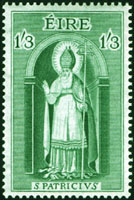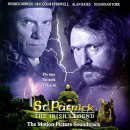| |

Traditions, folklore, history and more. If it's Irish, it's here. Or will be!
"People will not look forward to posterity who never look backward to their ancestors."
-Edmund Burke




Quotes
Library: Books, Movies, Music
Prints & Photos
Poetry
Jokes


Shops Ireland
Bunús na Gaeilge
(Basic Irish)
Circle of Prayer
Blessings
Did You Know?
Himself/Herself
Write to Us
Readers Write..
Links/Link to Us
Advertise with us
Awards & Testimonials
Submissions Guide


|
|
|
"I, Patrick, the sinner..."
by Bridget Haggerty

The high veneration in which the Irish hold St. Patrick is evidenced by the common salutation, "May God, Mary, and Patrick bless you." His name occurs widely in prayers and blessings throughout Ireland and it is said that he promises prosperity to those who seek his intercession on his feast day, which marks the end of winter.
Crops could not be safely planted, nor animals put out in the fields, before the fear of winter frost had passed. The appearance in one's garden of snowdrops, daffodils and crocus were fickle forecasters of better weather, as often as not popping up too soon, only to be covered by a late snow, or shriveled up by a sudden blast of frost. Indeed, such was the importance of getting the planting date correct, that the Celts had markers, to remind them when it was safe to plant, and later on, the early Christian Irish adopted these days as Saint's days, for St Brigid (Feb 1) and St Patrick (March 17). Thus the proverb went: "Every second day is good, from my day forward" says Brigid. "Every day is good from my day forward" says Patrick.
All well and good. But who was this man who legend says drove the snakes out of Ireland and used a shamrock to convert the heathens?
The Annals of the Kingdom of Ireland by the Four Masters state that by the year 438 Christianity had made such progress, the laws were changed to agree with the Gospel. In just 6 years, a 60 year old man was able to so change the country that even the laws were amended. He had no printing press, no finances, few helpers and Ireland had no Roman roads on which to travel.
Recorded history and mystical legend are cavalierly intertwined when it comes to St. Patrick. Some historians say he was born in Banwen, Wales. Others say it was Kilpatrick, near Dumbarton, in Scotland . As with many of the facts about his life, no-one is exactly sure where.
Even the date of his birth is disputed, although many historians place it about 385 A.D. Most of what is known comes from the saint's Confessions, a slim volume which he wrote before he died in the late 400s.
In Patrick's youth, the Roman Empire was in decline; without Roman protection, Britain was vulnerable to attack by marauding Irish pirates whose homeland had never been conquered or absorbed by Rome.
After one such raid, Patrick became one of the thousands captured and returned to Ireland as slaves; this was a devastating shock for one who had enjoyed a life of relative comfort as the son of a well-compensated church official.
Not only was he torn from home and family, but he also was taken to a land that, while not very distant, had to have seemed incredibly alien and frightening.
Roman expansion into Britain had brought law and order, advanced culture and infrastructure, and eventually, Christianity. Ireland, on the other hand, remained a harsh, difficult place where warring kings ruled violent small kingdoms and pagan priests performed human sacrifice.
Patrick was purchased by a Druid. Members of this mystical Celtic religion practiced magic, oversaw rituals and served as judges in the top echelons of ancient Irish society.
Once indifferent to the Christian teachings of his family, Patrick's attitude changed radically during his six-year captivity. As a shepherd in his master's lonely, misty fields, he writes of having only two constant companions - hunger and nakedness. In this isolated and degrading situation, Patrick wrote of his spiritual transformation: "The love of God - grew in me more and more, - in a single day, I have said as many as a hundred prayers, and in the night, nearly the same - I prayed in the woods and on the mountain, even before dawn. I felt no hurt from the snow or ice or rain."
Patrick dreamed of escape. He tells us that he stole away one night and hiked 200 miles to the nearest port, where he found a ship that was soon to embark. But, because he was a penniless slave, the captain refused him passage. Patrick then prayed for several hours in a nearby wood; he returned to the ship, and miraculously the captain relented and gave him a place on the ship, possibly as a sailor.
History does not record precisely where the ship landed, but it was most likely along the coast of France, then known as Gaul. Details about how Patrick finally reached his family in Britain are also very sketchy. But, he did make it home and was haunted by his experiences in Ireland.
Convinced that God had summoned him to return to the pagan land of his captivity, Patrick trained for the priesthood. Some historians believe that he did so in France under the tutelage of St. Germain. Others say he trained in Rome. Regardless, he was assigned as a missionary to Ireland.
A few others had preceded him but with little success. Patrick's immediate predecessor, in fact, was said to have been martyred. Territorial kings and intransigent Druids proved powerful barriers to Christianity, then synonymous with Roman domination as the church and its popes filled the void left by departing emperors.
Patrick faced very real danger but had an advantage. Having lived among the Irish for six years, he was familiar with their ways. That and a persuasive personality were vital to his eventual success.
Though Ireland is smaller than the state of Maine, it had many kings,each ruling tiny kingdoms called tuatha. Above them were kings of the five provinces, in turn subject to the high king seated at Tara, then the capital. Patrick knew he had to appeal to the fiercely independent minor monarchs in order to spread his message safely. Greasing their royal palms helped.
"I spent money for your sake in order that they might let me enter," he addresses his superiors, recounting his mission in Confessions. "I made presents to the kings, not to mention the price I paid to their sons who escorted me."
Underscoring the need for such royal protection, Patrick frequently referred to the dangers he faced in Ireland. Sometimes, the patronage of a king wasn't enough to keep him safe.
At one point, he tells of being attacked, bound, robbed and threatened with death, all while under "protection." But because the kings constantly battled with each other, it was important to court all of them.
Having friends in high places helped Patrick's mission in other ways. Although he made few converts among kings who offered him safe passage, their fortunes being too closely related to maintaining the old order, his message often attracted other members of the royal families with less to lose, including younger brothers with little hope of inheritance from their fathers.
As Ludwig Bieler, the mid-century church historian, noted, when the highest echelon of society adopted the new faith, the people often followed.
But royal favor doesn't begin to explain Patrick's transforming effect on the people. History cannot always interpret such intangibles. There is little contemporary documentation of Patrick's mission by chariot throughout Ireland, converting thousands and establishing churches.
Later hagiographers -- people who write about saints -- give vivid yet ultimately unreliable details about Patrick's conversions and wondrous acts. His most famous "miracle," driving the snakes out of Ireland, certainly is legend - geologists say the island broke off the European continent before snakes could evolve there. The story most likely is intended to be emblematic of how he purged paganism.
But Patrick's dynamism was so great that myths abounded. "He must have been a terrifically charismatic figure," says Robert Mahony, an associate professor of English at Catholic University and former director of the Center for Irish Studies there. "And such people inspire legends."
 One legend that is not widely known is Les Fleurs de St-Patrice which says that Patrick was sent to preach the Gospel in the area of Bréhémont-sur-Loire. He went fishing one day and had a tremendous catch. The local fishermen were upset and forced him to flee. He reached a shelter on the north bank where he slept under a blackthorn bush. When he awoke the bush was covered with flowers. It was Christmas day and from that time on, the bush flowered every Christmas until it was destroyed in World War I. The phenomenon was seen and verified by various observers, including official organizations. Today, St. Patrick is the patron of the fishermen on the Loire and, according to a modern French scholar, the patron of almost every other occupation in the area. One legend that is not widely known is Les Fleurs de St-Patrice which says that Patrick was sent to preach the Gospel in the area of Bréhémont-sur-Loire. He went fishing one day and had a tremendous catch. The local fishermen were upset and forced him to flee. He reached a shelter on the north bank where he slept under a blackthorn bush. When he awoke the bush was covered with flowers. It was Christmas day and from that time on, the bush flowered every Christmas until it was destroyed in World War I. The phenomenon was seen and verified by various observers, including official organizations. Today, St. Patrick is the patron of the fishermen on the Loire and, according to a modern French scholar, the patron of almost every other occupation in the area.
Thomas Cahill, author of How the Irish Saved Civilization, believes that part of Patrick's appeal lay in his message. In a 1996 CNN interview, Cahill noted that "the Christianity that Patrick planted in Ireland was really of a unique kind, in the sense that he left behind all of those dark, sad mediations on human sinfulness that were favorites of the fathers of the Church, and instead he concentrated on the goodness of creation.
"The Irish were already very mystical. They believed that the world was a magical place, and he built on that rather than on this human sinfulness theme, and, as a result, early Irish Christianity was extremely celebratory of the world, of the earth, of matter, of human experience, of the human body. It gets off the ground very quickly in this kind of dance of happiness and joy which is very unlike the sound of earlier Christianity."
There is no reliable account of St. Patrick's work in Ireland. Legends include how he described the mystery of the Trinity to Laoghaire, high king of Ireland, by referring to the shamrock, and that he singlehandedly--an impossible task--converted Ireland. Nevertheless, Saint Patrick established the Church throughout Ireland on lasting foundations: he travelled throughout the country preaching, teaching, building churches, opening schools and monasteries, converting chiefs and bards, and everywhere supporting his preaching with miracles.
His writings show what solid doctrine he must have taught his listeners. His "Confessio" (his autobiography, perhaps written as an apology against his detractors), the "Lorica" (or "Breastplate"), and the "Letter to the Soldiers of Coroticus," protesting British slave trading and the slaughter of a group of Irish Christians by Coroticus's raiding Christian Welshmen, are the first surely identified literature of the British or Celtic Church.
What stands out in his writings is Patrick's sense of being called by God to the work he had undertaken, and his determination and modesty in carrying it out: "I, Patrick, a sinner, am the most ignorant and of least account among the faithful, despised by many. . . . I owe it to God's grace that so many people should through me be born again to him."
St. Patrick died at Saul (Sabhall) on March 17 493. Saint Tassach administered the last rites and his remains were wrapped in a shroud woven by Saint Brigid. The bishops, clergy and the faithful from all over Ireland crowded around his remains to pay due honor to the Father of their Faith. Some of the ancient Lives record that for several days the light of heaven shone around his bier. His remains were interred at the chieftan's fort two miles from Saul. Centuries later, the cathedral of Down was built where St. Patrick was buried.
There is another old legend that promises that on the last day, though Christ will judge all the other nations, it will be St. Patrick sitting in judgment on the Irish. In an interview, when Thomas Cahill was asked whether that spelled good news or bad news for the Irish, Cahill didn't hesitate. "That's great news for the Irish!" Resources: The Irish Heritage Newsletter and several web sites including The Catholic Messenger
|
|
Fri, Sep 27, 2024
 The Galway Hooker The Galway Hooker
This unique vessel, with its distinctive curved lines and bright red sails, originated in the village of Claddagh. During the 19th century, hookers supported a significant fishing industry and also carried goods, livestock and fuel. Seán Rainey is remembered for building the last of the original boats, the Truelight, for Martin Oliver who was to become the last king of the Claddagh; as king, he was entitled to white sails on his boat. Since the mid seventies, many of the old sailing craft which were on the verge of extinction have been lovingly restored and new ones have been built. During the summer months they can be seen at festivals such a Cruinniú na mBád - the Gathering of the Boats - in Kinvara.
Click for More Culture Corner.
|
St. Patrick - The Irish Legend CD

Five stars from two amazon reviewers.
I liked the movie, but I was even more impressed by the wonderful soundtrack. The score is made up of orchestrations, whistles and flutes, harp, and the touching uillean pipes. I must say that this CD is very, very beautiful and spiritual. amazon reviewer
Click Here for The Irish Legend - CD
|
...made for television movie is entertaining, inspiring, and educational. St. Patrick is one of the most well known, yet least "known about" significant personalities in world history.
Amazon Reviewer
Available in VHS or DVD, Click below for The Irish Legend Movie.
Click for VHS.
Click for DVD.
|
|
|
|
|




 The Galway Hooker
The Galway Hooker